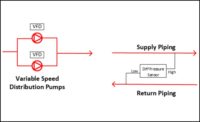The commissioning process often includes the commissioning provider giving recommendations to various team members to address current or foreseen issues with system operation. Such recommendations are not always taken blindly, which is not a bad thing. Ideally, recommendations for addressing complex issues will prompt healthy collaboration between team members who all keep an open mind and remain committed to doing the right thing for the building. Unfortunately, there are plenty of conversations that don’t go that way — people get offended, are annoyed, or feel obligated to say whatever they can to avoid addressing the issue at hand. Below are a few phrases I’ve heard enough to know they’re an indication of a participant’s unwillingness to address the issue.
“We always include this in our designs and have never received feedback that it has created issues.”
I’ve heard variations of this statement from many design engineers in response to recommendations that come up during design reviews. It seems logical on the surface, but I have two counterarguments to it.
- I typically try to support my recommendations with real-world experience of the issue at hand. Where I might be lacking that, I poll my colleagues for supporting case studies to prove the point. The fact that I am providing the recommendation in the first place is my attempt to provide the feedback they never seem to be getting, which I would argue is one of the greatest benefits of the commissioning process.
- Design engineers need to understand the social limitations that prevent them from getting such feedback from others. For example, a lot of the recommendations I provide are regarding improvements to system automation. Who on the construction team understands the intricate nuances of a failed control sequence better than the controls programmer? Do you think they have been given a greenlight from their superiors to call the design engineer to talk through such issues when they arise? No. That would typically be considered breaking rank. So, it leaves them with three choices:
- Don’t address the issue as they complied with the specification.
- Address the issue (hopefully in a correct manner) but don’t waste their time communicating the field modification to the design team. That may entail a barrage of questions that will slow them down.
- Identify the issue to the design team and await direction.
That latter option is what would seem to be the right thing to do. Typically, this involves a game of telephone that probably includes several much less controls-savvy individuals serving as middlemen between the controls programmer and design engineer. Needless to say, the design engineer doesn’t get the full story by the time they’re made aware there is an issue. One might think an established Request For Information (RFI) process would avoid explanations of such issues being lost in translation. In my experience, the more nuanced the control sequence issue is, the less like it will make its way onto an RFI. On most of my projects, the controls programmer doesn’t even know the name of the design engineer. And, they certainly don’t have an appetite to go toe to toe with a design engineer if they can avoid it. I attempt to break down those walls and establish the relationship between the two by inviting the designer engineer to functional testing or routinely calling them while in the field with the controls programmer when clarifications are needed. This approach is usually welcomed by all involved, just as long as I keep the control contractor’s project manager, the mechanical contractor’s project manager, and the general contractor aware of the conversations.
If the issues are not identified/addressed during construction, then the building operations staff live with the problem. Depending on their competence level, they may never identify the root cause of what they are seeing. And, if they do, they most likely don’t have an avenue or the appetite to track down the design engineer to provide a little feedback. I certainly don’t track down the designer of my car when I realize I have to remove the bumper to replace the headlight bulb 10 years after I purchased the vehicle.
"I've been doing this for xx years ... "
There are appropriate occasions for floating one’s longevity in the industry, like in your résumé, fee proposal, etc. If someone insists on quantifying their experience instead of qualifying it, they have had tunnel vision for too long. And, if they state this in a defensive manner, they are grasping at straws. I don’t care if you have 100 years of experience — if you don’t take the time to critically think about the issue at hand, you are bound to make the same mistake over and over again.
On a past project, a hydronic system was specified to operate in a variable-speed manner with control valves at served water-source heat pumps closing when the heat pumps disabled. The control valves serving those heat pumps did not close, however, resulting in the system pumps essentially running full speed all the time, even when none of the served heat pumps were running. This issue was identified during the functional testing phase. During a commissioning coordination meeting, a member of the construction team stated to the owner, “I’ve been in this industry for 30 years, and in my experience, constant-speed pumping systems operate far better and use less energy than variable-speed pumping systems.” Not only was this comment laughable, but its timing was also quite odd. He was trying to sell the current state of the system as being better for the owner. Yet, the construction team was already committed to, and well on their way to resolving the issue to make the system operate in a variable-speed manner. In this particular instance, no one responded to the individual making this claim, we basically just ignored him. However, I usually attempt to respond to such boasting by asking, “With all your experience, I’m sure you’ve seen this issue before — what have you been done on previous projects to resolve it?”
"This is industry standard."
I’ve heard this a lot. To be honest, I’ve used this phrase myself. But I pause whenever I hear it, or prior to using it myself, because a fundamental belief of mine is that this industry is extremely broken (hence the reason for commissioning). There are plenty of “industry standards” that exist — some are adequate, and plenty have a lot of room for improvement. But too many individuals use this phrase to dodge having to think critically or do more work.
I once worked with an insulation contractor who loved this phrase. He was reinsulating chilled water piping in a building, and there were numerous locations where condensation was dripping out of broken seams in the newly installed closed-cell foam insulation. This primarily occurred at piping transitions (elbows, T’s, etc.). He felt the dripping was OK because he installed the insulation to “industry standard.” He also used the phrase when I questioned why he did not continuously insulate a pipe as it transitioned through a wall penetration. He instead ran insulation up to the drywall on each side, but kept the pipe uninsulated within the wall cavity itself. He insisted this was “industry standard” on how to insulate in a “dead space that has no moisture in the air.” Water dripping down the outside of the wall from below the pipe was OK to him, and he felt it should be OK to the building owner as well. Needless to say, his entire installation was a hack job and didn’t comply with common sense or the insulation manufacturer’s installation instructions. It later had to be redone by a more competent co-worker of his.
On a separate project, it was identified that a large hydronic system in the building didn’t have any drains or vents. When questioned, the design/build contractor stated that providing the ability to drain a hydronic HVAC system is not industry standard. We presented a blatantly clear code reference stating otherwise. He didn’t back down. When asked why he felt they were not needed, he stated because “a properly installed system shouldn’t ever need to be drained.” This was ironic because this lack of drain valves was only identified when he was brought back to repair numerous leaks in the system his team installed. After more debate than you could believe, appropriate drains and vents were installed during their leak repairs.
So how do you respond to the phrase, “this is industry standard,” when trying to solve an obvious issue? If what they are referring to truly is an industry standard that has room for improvement, then you can spin it as an opportunity for them to find a better way and move the industry forward. If they use this phrase to blatantly avoid having to perform more work, then it may not be worth trying to collaborate with them further. In my experience, people using the phrase in this context are usually just trying to gaslight you into believing they’re the expert and you’re not, so you should stay quiet and look the other way. That’s when you might have to get a bit more assertive. There is usually more than enough leverage either in the project documents, manufacturer installation instructions, and the owner or engineer-of-record’s influence to ensure the situation is properly addressed.
Conclusion
The commissioning process, at times, includes some difficult conversations when problem-solving. I have seen tempers flare, but if one can keep an open mind, remain calm, and stay focused on addressing the issue at hand, the correct solution will be found. This article sought to identify a few common resistances you might face along the way, and hopefully give you some ideas on how to address them.





